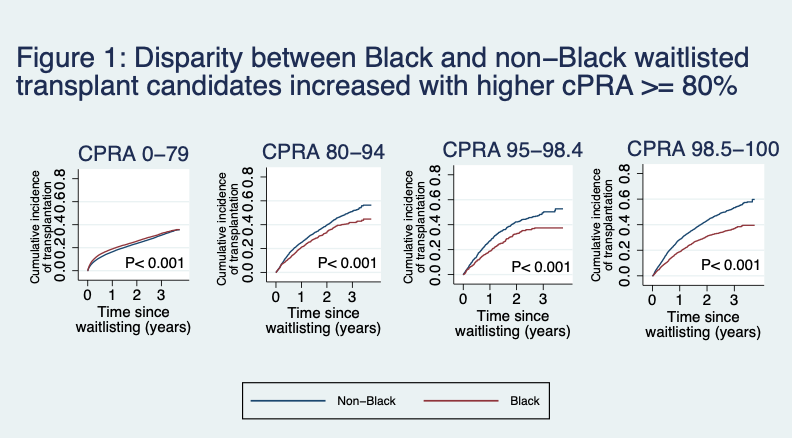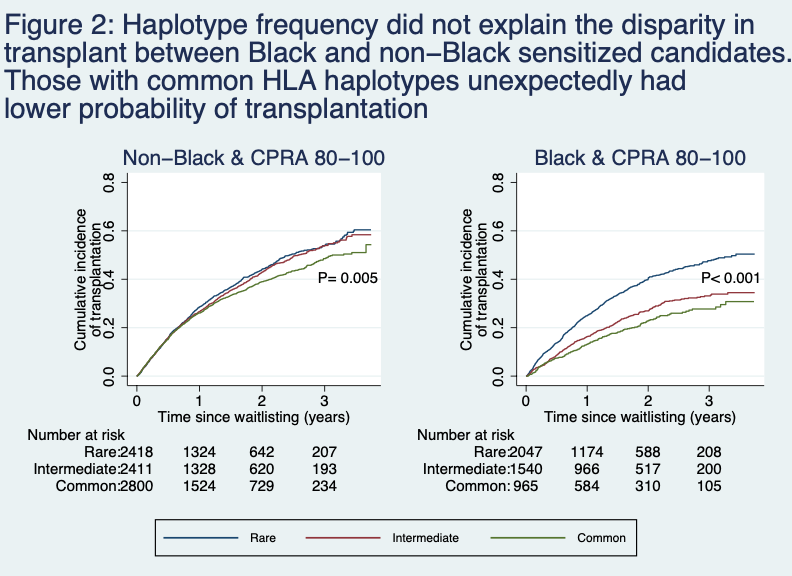HLA Haplotype Frequency and Racial Disparities in Access to Transplant Among Highly Sensitized Kidney Transplant Candidates
1Tulane University, New Orleans, LA, 2University of British Columbia, Vancouver, BC, Canada, 3Emory University, Atlanta, GA, 4UNOS, Richmond, VA, 5Cedars-Sinai, Beverly Hills, CA, Canada
Meeting: 2021 American Transplant Congress
Abstract number: 828
Keywords: Highly-sensitized, Histocompatibility, Kidney transplantation, Waiting lists
Topic: Clinical Science » Kidney » Kidney Deceased Donor Allocation
Session Information
Session Name: Kidney Deceased Donor Allocation
Session Type: Poster Abstract
Session Date & Time: None. Available on demand.
Location: Virtual
*Purpose: Despite implementation of the Kidney Allocation System (KAS) which prioritizes sensitized patients, sensitized Black individuals are less likely to receive a transplant than non-Black individuals on the waitlist. Given zero-mismatch transplants are more common among sensitized patients, we hypothesized that more sensitized Black candidates have rare HLA genotypes, resulting in fewer potential matches from the donor pool and a lower likelihood of transplantation compared with non-Black candidates.
*Methods: We analyzed a retrospective cohort of adult kidney transplant candidates (N=87174) from the 2019 USRDS database who were waitlisted post-KAS (Dec 4, 2014). The most likely HLA genotype for each candidate was imputed using the NMDP HapLogic algorithm from serologic HLA typing and categorized into “Common”, “Intermediate” and “Rare” based on observed frequencies in the overall candidate population. Cumulative incidence of transplant from listing date was stratified by cPRA, race, and HLA genotype frequency.
*Results: Black candidates had reduced probability of transplantation compared to non-Black candidates only when cPRA was >= 80%, and this disparity widened with higher cPRA (Fig 1). This effect remained significant after adjusting for competing risks of death/waitlist removal and ABO blood group. Candidates with common HLA genotype frequencies had the lowest incidence of transplantation in all candidates; however, Black candidates had a lower cumulative incidence of transplant relative to non-Black candidates, regardless of HLA genotype frequency (Fig 2).
*Conclusions: Disparity in access to transplant between Black and non-Black transplant candidates is greater with increasing cPRA above 80%. This disparity is not explained by HLA genotype frequencies. Why the disparity widens with increasing cPRA remains uncertain. Contrary to our hypothesis, patients with common HLA frequency had the lowest access to transplantation. This unexpected phenomenon requires further studies.
To cite this abstract in AMA style:
Gragert L, Kadatz M, Chang D, Gebel H, Stewart D, Kransdorf E, Brar S, Vaishnav S, Gill J, Lan J. HLA Haplotype Frequency and Racial Disparities in Access to Transplant Among Highly Sensitized Kidney Transplant Candidates [abstract]. Am J Transplant. 2021; 21 (suppl 3). https://atcmeetingabstracts.com/abstract/hla-haplotype-frequency-and-racial-disparities-in-access-to-transplant-among-highly-sensitized-kidney-transplant-candidates/. Accessed December 27, 2025.« Back to 2021 American Transplant Congress


